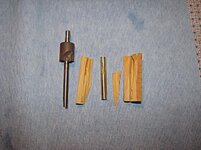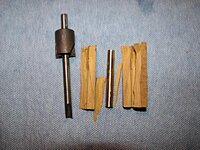ColoradoHermit
Member
I've been having a lot of problems with blocks splitting or chunks breaking off when using the block trimming tool. I've tried running it faster & slower RPMs, I've tried the high speed steel 5/8 dia. and the 3/4 dia. Those only lasted long enough to do the blocks for 10 or at most 15 pens.
So I went all out and got the PSI carbide trimmer. After trimming only about 5 blocks it split a piece of Yellow Heart in half, broke the corner off of a block of Zebra wood and just mangled another Zebra wood block. Doesn't matter what speed I've tried, from around 250 RPM, 450 RPM, 700 RPM, 1200 RPM. It still wants to split every thing. Grain doesn't matter either, strait or angled. Strait gets split, angled gets mangled.
Here's a couple picture of the yellow heart the carbide trimmer split. This is the only one that I've taken a picture of, so far. I've had to go back to trimming them with the disc sander but that just fills the shop with dust.
I got one of those funky self centering vise's, but it wont repeat holding the same block in the same position for the top and the bottom is even worse. I can put a block back in the vise and never get the hole to line up. And it's a brand new 12 inch, 1/2 hp Drill Press that I bought last spring. I've checked the table with a dial indicator and its right on square with the spindle. Since I can't use the vise I Have to use Chanel lock pliers to hold the blocks.
Any body else out there having this problem? Is this something that's pretty common and just have to put up with it? I hate having to use the disc sander cuz of all the dust.
Does anybody know where to order a good quality cutter &/or some place to send them to be sharpened?
Thanks Y'all
So I went all out and got the PSI carbide trimmer. After trimming only about 5 blocks it split a piece of Yellow Heart in half, broke the corner off of a block of Zebra wood and just mangled another Zebra wood block. Doesn't matter what speed I've tried, from around 250 RPM, 450 RPM, 700 RPM, 1200 RPM. It still wants to split every thing. Grain doesn't matter either, strait or angled. Strait gets split, angled gets mangled.
Here's a couple picture of the yellow heart the carbide trimmer split. This is the only one that I've taken a picture of, so far. I've had to go back to trimming them with the disc sander but that just fills the shop with dust.
I got one of those funky self centering vise's, but it wont repeat holding the same block in the same position for the top and the bottom is even worse. I can put a block back in the vise and never get the hole to line up. And it's a brand new 12 inch, 1/2 hp Drill Press that I bought last spring. I've checked the table with a dial indicator and its right on square with the spindle. Since I can't use the vise I Have to use Chanel lock pliers to hold the blocks.
Any body else out there having this problem? Is this something that's pretty common and just have to put up with it? I hate having to use the disc sander cuz of all the dust.
Does anybody know where to order a good quality cutter &/or some place to send them to be sharpened?
Thanks Y'all


